written and photographed by Mary L. Peachin
Mar 2002, Vol. 6 No. 5
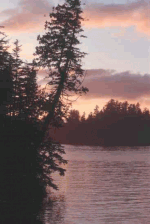 In the early hours of the morning, anglers gather in the South terminal near Vancouver International Airport. Many boast t-shirts from other fishing destinations, and a few lovingly grasp new rod cases. Though a good number are exhausted by jetlag or late night pre-fishing partying, their excitement permeates the small building. Those arriving on inbound flights from fishing camps line up at baggage claim, eager to pick up their boxed trophies: personally caught cases of fresh, smoked, or canned salmon. Once they’ve claimed their fish, they share stories with the outgoing anglers, who are headed out to the Queen Charlottes, Vancouver and Malcolm Islands, Desolation Sound, Princess Royal Island or inland to the Kootenays, Kamloops, Skeena, and Chilcotin regions of British Columbia.
In the early hours of the morning, anglers gather in the South terminal near Vancouver International Airport. Many boast t-shirts from other fishing destinations, and a few lovingly grasp new rod cases. Though a good number are exhausted by jetlag or late night pre-fishing partying, their excitement permeates the small building. Those arriving on inbound flights from fishing camps line up at baggage claim, eager to pick up their boxed trophies: personally caught cases of fresh, smoked, or canned salmon. Once they’ve claimed their fish, they share stories with the outgoing anglers, who are headed out to the Queen Charlottes, Vancouver and Malcolm Islands, Desolation Sound, Princess Royal Island or inland to the Kootenays, Kamloops, Skeena, and Chilcotin regions of British Columbia.
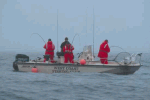 Each summer, more than 150,000 anglers pass through Vancouver to fish in British Columbia. For some, it’s their first fishing adventure, while others are professional guides who welcome the diversity and quality (read, “trophy-size fish”) of BC angling. Whether they’re fly fishermen, trollers, or deep-water anglers, they’re in BC to find fish, and plenty of them.
Each summer, more than 150,000 anglers pass through Vancouver to fish in British Columbia. For some, it’s their first fishing adventure, while others are professional guides who welcome the diversity and quality (read, “trophy-size fish”) of BC angling. Whether they’re fly fishermen, trollers, or deep-water anglers, they’re in BC to find fish, and plenty of them.
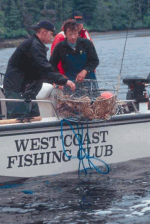 For those who occasionally lift their heads from the rod, the beauty and diversity of the environment is on par with the fishing. The Queen Charlotte Islands, about 50 miles southwest of Alaska’s southernmost point, offers visitors a rugged beauty, with an inland landscape of pinnacles of volcanic rock and craggy shorelines whose jagged foliage shows the effect of years of gale-force winds. Further south, the west coast of Vancouver Island offers similar rugged views, against a backdrop of mountaintop glaciers.
For those who occasionally lift their heads from the rod, the beauty and diversity of the environment is on par with the fishing. The Queen Charlotte Islands, about 50 miles southwest of Alaska’s southernmost point, offers visitors a rugged beauty, with an inland landscape of pinnacles of volcanic rock and craggy shorelines whose jagged foliage shows the effect of years of gale-force winds. Further south, the west coast of Vancouver Island offers similar rugged views, against a backdrop of mountaintop glaciers.
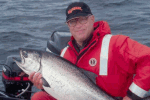 Wildlife abounds throughout the region. In the Queen Charlottes, bald eagles seem as common as sparrows, and it’s easy to spot peregrine falcons and tufted puffins. Well-fed black bears scavenge the beaches during low tide, ignoring the small-racked Sitka deer. In the interior, anglers share the wilderness with grizzlies and black bear, and lakes echo with the distinctive call of the loon. Passengers on inland flights often fly over small herds of Dall sheep, migrating over the glacier-draped mountains.
Wildlife abounds throughout the region. In the Queen Charlottes, bald eagles seem as common as sparrows, and it’s easy to spot peregrine falcons and tufted puffins. Well-fed black bears scavenge the beaches during low tide, ignoring the small-racked Sitka deer. In the interior, anglers share the wilderness with grizzlies and black bear, and lakes echo with the distinctive call of the loon. Passengers on inland flights often fly over small herds of Dall sheep, migrating over the glacier-draped mountains.
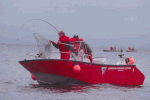 The pleasures of civilization, or at least those important to the serious angler, are all here. In spots from the Queen Charlottes to Princess Royal Island near Prince Rupert, from the mainland shore to Vancouver Island, visitors can eat well and heartily. Those looking for a little luxury have their choice of some of the finest upscale resorts. Neither is the fishing infrastructure lacking, for luxury or budget travelers: Anglers can hire personal fishing guides, or tow their own boats directly to the water.
The pleasures of civilization, or at least those important to the serious angler, are all here. In spots from the Queen Charlottes to Princess Royal Island near Prince Rupert, from the mainland shore to Vancouver Island, visitors can eat well and heartily. Those looking for a little luxury have their choice of some of the finest upscale resorts. Neither is the fishing infrastructure lacking, for luxury or budget travelers: Anglers can hire personal fishing guides, or tow their own boats directly to the water.
The West Coast Fishing Club Outpost is 26 miles (as the helicopter flies) south of the Haida Gwaii village of Masset, in the Queen Charlottes. This small but luxurious eight-room lodge (which is not technically a club) is tucked among the pines on a hillside perched high above the protected natural harbor of Port Louis. Fine art hangs on hand-hewn log walls, gourmet meals, many featuring local Dungeness crabs, are served up daily, a hot tub soothes tired muscles after a long day on the water.
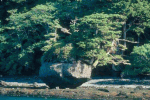 Here, the fishing is unprotected by bays or coves. Smaller facilities limits the number of anglers. Salmon fishing on the open water is done with downriggers and on a rough day fighting one of these trophy-size salmon in a tossing boat can be quite a balancing act. Both lures, and when available, herring is used as bait. (to read more about the West Coast Fishing Club, click here.)
Here, the fishing is unprotected by bays or coves. Smaller facilities limits the number of anglers. Salmon fishing on the open water is done with downriggers and on a rough day fighting one of these trophy-size salmon in a tossing boat can be quite a balancing act. Both lures, and when available, herring is used as bait. (to read more about the West Coast Fishing Club, click here.)
Further north in the Queen Charlottes, the westerly island of Langara is the base for the two Langara lodges, a 175-foot floating barge and a smaller, island-based hillside lodge. The West Coast Fishing Club also has several lodges on the island.
Fishing in the Queen Charlottes, as gorgeous as it may be, is for the hard-core angler. The land of the Haida Gwaii is rugged, regularly host to gale-force winds and rough water. This is not a place for the faint of stomach, or for those who melt in the rain. But the salmon average 25 pounds, and many visitors catch 30-plus-pounders, or “tyees.”
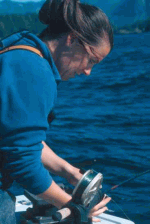 At Langara Lodge, they’re serious about fishing. No sooner does the floatplane tie up at the lodge’s dock than the orientation begins. There’s a quick review of the catching limits for each fish taken and procedures for salmon that will be cleaned, filleted, and flash-frozen or canned. Then it’s on to the locker room, to pick up rubber boots and bright red survivor suits (for emergency floatation as well as weather protection).
At Langara Lodge, they’re serious about fishing. No sooner does the floatplane tie up at the lodge’s dock than the orientation begins. There’s a quick review of the catching limits for each fish taken and procedures for salmon that will be cleaned, filleted, and flash-frozen or canned. Then it’s on to the locker room, to pick up rubber boots and bright red survivor suits (for emergency floatation as well as weather protection).
General manager Bill Gibson gives a quick safety talk, emphasizing the lodge’s policy against beach landings for bathroom stops: “Most drowned men have been found with their zippers down.” I chuckle and a nearby gentleman asks why I am laughing. “Just jealous,” I respond, knowing that as the trip’s lone female, my only option is a bucket. Bill talks about the most effective use of herring bait (it needs to spin), and how fishing lines should drift at a 45-degree angle. He runs through the “flex-day schedule,” which permits anglers to fish from five in the morning to nine at night. Anglers can return to the lodge for meals at any time, or for coffee from its the espresso bar, although true diehards rely on the twice-daily sandwich run, courtesy of an orange Zodiac that doubles as the safety boat.
Neither is there much coddling at the lodge: the morning wake-up knock reverberates down the hallway at five A.M. By six, the anglers are heading through the fog-filled Parry Passage for the 15-minute trip to the fishing grounds at Coho Point. Here, in one of the most remote and beautiful places in British Columbia, they meet up with the boats from the other lodges based in Henslung Cove. Under swooping and diving eagles that fish the same waters, boats huddle together, “mooching” or trolling just above idle speed. As the day progresses, the fishermen follow the ebb or flood of the tide into waters where they hope “the bite” will happen.
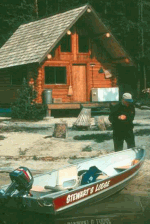 And it does, repeatedly. Langara guides don’t exaggerate when they talk about the sheer number of salmon that pass the islands. In two full and two half days there, I caught and released 45 Chinook, Coho, pink, and chum salmon. There was also plenty going on between casts. Several times, we pulled in the fishing lines and headed to nearby “Humpback Alley” for some whale watching, quietly following the huge creatures until they sounded with a flip of their enormous tails. (to read more about Langara click here)
And it does, repeatedly. Langara guides don’t exaggerate when they talk about the sheer number of salmon that pass the islands. In two full and two half days there, I caught and released 45 Chinook, Coho, pink, and chum salmon. There was also plenty going on between casts. Several times, we pulled in the fishing lines and headed to nearby “Humpback Alley” for some whale watching, quietly following the huge creatures until they sounded with a flip of their enormous tails. (to read more about Langara click here)
As the moon slips behind the peaks of Vancouver Island, fishers hurry to catch the slack tide, that magical time where herring bunch attracting ravenous school of salmon for a hopeful morning salmon bite for the fisher. Sleepily, they wander down the lawn to the dock for a long 10-12 hour day of fishing.
Secluded Sund’s Lodge, tucked on the northern shoreline of Malcolm Island is a lodge for anglers who want to combine serious fishing with the amenities of gracious living, gourmet cuisine, fine cabin accommodations and the personal touch of a family owned operation.
Dave and Sally Sund and son Scott are celebrating 20 years of operating this small lodge. There is nothing rustic about the place. Appointments exude a personal touch and to name just a few include Dave’s personal collection of duck decoys, couches upholstered with a “gone fishin” motif, candy bar gift baskets in each cabin plus a personalized welcome card with a book about the history of the lodge and its gentle philosophy of customer service.
When guests aren’t fishing (the few hours they are dining or sleeping), friendly staff is looking out for their every need. In fact, if a guest is sleeping, a knock on the door wakes everyone at four in the morning or for evening cocktail hour.
Sund’s is prepared for the healthy appetite, and the food is not only plentiful, it is gourmet. The staff includes two young chefs who know their cooking and for better or worse (for those who might be weight conscious) make homemade bread and scrumptious desserts, which are served at both lunch and dinner.
At the crack of dawn, five twenty-six foot Aluminum Chambered Boats with 222-horsepower Mercury engines and a trolling motor wait dockside.
Our first day of fishing was a grueling non-productive twelve hours. Guide Geoff Millar uses anchovies and hoochie lures in a valiant effort to get fish to bite in unusually windy conditions. Some of us were more distracted by a pod of killer whales and fishing bald eagles, more plentiful than sea gulls. Lodge guests during my board visit were almost exclusively fathers and sons. (to read more about Sund’s Lodge click here)
For anglers who want easy fishing without the need for seasickness meds, King Pacific Lodge on Princess Royal Island, an hour by floatplane south of Prince Rupert, has to be the world’s most luxurious (and expensive) floating lodge.
The King Pacific boasts a majestic dining room, video and game room, spa with hot tub and treadmill, and on-call massage therapist. The main room of the lodge features a massive two-story stone fireplace. The natural slate floor leads to a “dry room” housing each guest’s bright-red Mustang survival suit (for warmth and safety) and pair of rubber boots. An outside porch leads to the dock, where visitors can enjoy a westerly view of the mountains surrounding the harbor. Upstairs, 18 spacious bedrooms have king-size duvet-covered beds, flanked by wall-to-wall windows framing views of the harbor or rainforest. Each bathroom has a full shower and large soaker tub. A basket of amenities include a nubby massage roller designed to sooth sore fishing muscles.
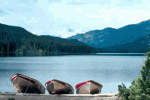 Guests are pampered from the moment of arrival, and gourmet meals take priority over the fish bite. There’s plenty of great salmon fishing to be had, plus hiking, kayaking, and whale watching. Then there’s the heli-fishing, which the lodge bills as the ultimate fly-fishing experience.
Guests are pampered from the moment of arrival, and gourmet meals take priority over the fish bite. There’s plenty of great salmon fishing to be had, plus hiking, kayaking, and whale watching. Then there’s the heli-fishing, which the lodge bills as the ultimate fly-fishing experience.
On my heli-fishing expedition, I enjoyed the view as pilot Paul Tosczak skimmed his bright-red Bell 260 helicopter just above the treetops that line the Quall River inlet, searching the crystal-clear water for schools of pink salmon. He spied the fish, and gently landed in a green meadow dotted with spring flowers.
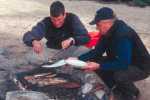 Hopping out under the spinning rotors, guide Wayne Boles assembled two 8-weight fly rods with pink “show-girls,” a feathery fly that swells to resembles a leech when soaked in the current. “These fish aren’t interested in feeding. They are on a mission; they’re focused on spawning. That flash of pink on the fly just pisses them off and they go for it.” Sure enough, on the first cast I hooked into a six-pound pink (also known as a humpie for its rounded back). Wayne, pointing to sea lice on the tail, explains that the lice can’t live in fresh water: “This fish just entered the river to begin its spawning journey.” We continued to catch and release the humpies until Wayne noted clumps of grass carried by on the current. A bear upstream, he explained. And sure enough, as we flew over the river and on to another prime fishing spot, we saw the bear feeding on the bank. (to read more about King Pacific Lodge click here)
Hopping out under the spinning rotors, guide Wayne Boles assembled two 8-weight fly rods with pink “show-girls,” a feathery fly that swells to resembles a leech when soaked in the current. “These fish aren’t interested in feeding. They are on a mission; they’re focused on spawning. That flash of pink on the fly just pisses them off and they go for it.” Sure enough, on the first cast I hooked into a six-pound pink (also known as a humpie for its rounded back). Wayne, pointing to sea lice on the tail, explains that the lice can’t live in fresh water: “This fish just entered the river to begin its spawning journey.” We continued to catch and release the humpies until Wayne noted clumps of grass carried by on the current. A bear upstream, he explained. And sure enough, as we flew over the river and on to another prime fishing spot, we saw the bear feeding on the bank. (to read more about King Pacific Lodge click here)
Closer to Vancouver, a chartered flight to Desolation Sound, Sonora Resort offers a similar experience to King Pacific Lodge on a grander, more corporate level. Angling the waters for Pacific Northwest salmon here, whale watching or landing on a glacier, Luxury accommodation and gourmet cuisine is a great way to enjoy the untouched beauty of coastal British Columbia – where your only neighbors are grizzly bears and bald eagles. (to read more about Sonora click here)
Some anglers who visit the province forego the lodges entirely and head straight for the boat. Beyond the northwest end of the road on Vancouver Island, an hour’s floatplane trip up Nootka Sound, the 83-foot Daleanne 3 floats in the lee of a cove about five minutes by boat from the First Nations village of Kyoquot. Its 10 staterooms, four shared baths, and two showers will be home to twelve guests for the next three nights.
Captain Marilyn Murphy has been fishing since she was a kid. She’s been a guide for the family-operated Murphy Sportfishing almost half of her 26 years. The woman can tie knots, set out lines, find fish and out fish most anglers, male and female. The fishing in these waters can be as rugged as the Queen Charlottes, but the small coastal Barrier Islands offer an escape to fish more protected waters. When Coho salmon are schooling on the surface, Marilyn pulls out her fly rods, a more exciting experience than trolling deep with downriggers.
 Taking a 97,000-ton ship through open seas in stormy conditions is not a trip for amateurs. Each spring for the past six years, Marilyn, who has a Master Limited captain’s rating, has motored the ship from the family’s lodge on the Stamp River in Point Alberni. Offshore fishing can be rugged around Kyuquot. Twenty-five-knot winds are the norm, and Marilyn will fish 10-foot seas with northwester lies up to 40 knots. (Anglers with queasy stomachs can find calmer waters near the shore in the lee of the Barrier Islands, a group of lava rock formations that provides some protection from the elements.)
Taking a 97,000-ton ship through open seas in stormy conditions is not a trip for amateurs. Each spring for the past six years, Marilyn, who has a Master Limited captain’s rating, has motored the ship from the family’s lodge on the Stamp River in Point Alberni. Offshore fishing can be rugged around Kyuquot. Twenty-five-knot winds are the norm, and Marilyn will fish 10-foot seas with northwester lies up to 40 knots. (Anglers with queasy stomachs can find calmer waters near the shore in the lee of the Barrier Islands, a group of lava rock formations that provides some protection from the elements.)
On my third day fishing with Marilyn, we decide to fish behind the lee of Spring and Thornton Island. We begin by trolling for salmon with 9-weight fly rods, trailing flashers, and fly streamers called buck tails. I find the whir of salmon striking the fly even more exciting than the visual cue of the bent rod in deep-water fishing. I take a break and look around, enjoying the shore’s black-lava rocks covered with gulls and cormorants, the spruce trees capping each small island, the leaves of bull kelp gleaming in the sunshine. Marilyn comes up at my side. “I love the smell of low tide,” she says, inhaling the perfume of kelp, eelgrass, barnacles, and starfish. I do the same, and remember how much I love this region. (to read more about Kyuquot click here)
Like ocean anglers, those who prefer freshwater fishing have a wide variety of options in British Columbia. Many lodges throughout the province offer daily fly-in, fly-out floatplane trips to lakes or rivers. And in the Chilcotin region near Tweedsmuir Provincial Park, Stewart’s Lodge offers outpost camping.
For the past several summers, Stewart’s Lodge floatplane has flown the Peachin family into Shetler Lake, where we fend for ourselves in the wilderness for several days. OK, not exactly in the wilderness: The five of us share a single-room log cabin with a wood-burning stove and a nearby outhouse. If we don’t catch enough rainbow trout for dinner, Stewart’s has provisioned the cabin so we don’t go hungry.
We’ll spend the day trolling or fly casting for trout keeping only the fish we plan to grill up for dinner. Eagles and polka-dotted loons distract our focus on fishing. Our first chore at day’s end will be hauling lake water to purify for drinking. Not that it’s necessary, we don’t want to chance on getting giardia.
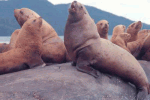 The first morning of our most recent visit, we were blessed with sun and a breezy, 60° F sunny day. Suzie and David motored one of the boats to a nearby inlet, docking and hiking inland a mile to a small upper lake called No Name, where the lodge had cached a two-passenger, three-horsepower boat. They enjoyed the glacial green water, so clear they could see the lake bottom. Meanwhile, Jeffrey, Kristin, and I decided to explore one of the streams that feed into Shelter Lake. We spotted a bald eagle tailing our boat, possibly looking for a handout. A pair of loons scooted away from the boat, protecting their single chick and shouting their distinctive call, which echoed across the lake. We take a break from fishing to hike along Whitton Creek, a stream that flows between Shelter and Crazy Bear Lake, next to a narrow mile-long hiking path.
The first morning of our most recent visit, we were blessed with sun and a breezy, 60° F sunny day. Suzie and David motored one of the boats to a nearby inlet, docking and hiking inland a mile to a small upper lake called No Name, where the lodge had cached a two-passenger, three-horsepower boat. They enjoyed the glacial green water, so clear they could see the lake bottom. Meanwhile, Jeffrey, Kristin, and I decided to explore one of the streams that feed into Shelter Lake. We spotted a bald eagle tailing our boat, possibly looking for a handout. A pair of loons scooted away from the boat, protecting their single chick and shouting their distinctive call, which echoed across the lake. We take a break from fishing to hike along Whitton Creek, a stream that flows between Shelter and Crazy Bear Lake, next to a narrow mile-long hiking path.
The second day, the five of us hiked the one-and-a-half mile Sunshine Lake canoe portage trail. We then waded down the creek, testing our flycasting skills, a slightly more active alternative to the previous days’ lake trolling. There are a few places with small rapids but most of the creek can be waded. We look for holes casting into them for hungry cutthroat. (to read more about Stewart’s Lodge click here)
The currents of the Skeena River flow through rugged glacier-covered mountain landscapes banked by thick forests. By the time the river empties into the Pacific Ocean at Prince Rupert in Northern British Columbia, it has flowed 350 miles.
The scenery is spectacular. In addition to the glacier-covered mountains, purple fireweed blend with yellow dandelions and lupine along a two-lane highway densely lined with pine, spruce hemlock, cottonwood, poplar and birch.Â
Andrew Rushton has been guiding on the river for 16 years, and he knows the river well. His Kalum River Lodge, located on 10 acres overlooking the river, could be better defined as a basic “part of the family” bed and breakfast, with lunch on the river and dinner included. If you are looking for luxurious accommodations and fine gourmet cuisine, Terrace might not be quite the place for you. But, avid fishers focus on the mighty Skeena. All five species of salmon plus steelhead, cutthroat, rainbow and Dolly Varden spawn in these waters.
During several days of fishing in August the Skeena produced highly prized steelhead, Coho and pink salmon, rainbow trout, and even a Dolly Varden. Andrew, his son Jeffrey and friend Cody Long and I tied up to a beach and didn’t see another angler during two days of fishing.
Most salmon fishers head to Terrace in July for king-size Chinook. A world record 99 pounder was caught here. During the month of August, all fish except Pink or Humpies must be released. This tends to keep “meat fishers”, those who don’t want to release salmon, away.
Almost two dozen steelhead hits our lines the first day. We used 8 1/2 foot St. Croix rods with bait casting 6500 Ambassador reels loaded with 20-pound test line. Our Spin and Glo lures were baited with salmon roe and weighted with 6-ounce lead. On 9-weight fly rods we used fly patterns of egg sucking leeches and shrimp imitators and both floating and sinking line.
Lakes, rivers, or oceans; luxury or bare bones, serious fishing surrounded by natural beauty British Columbia earns its reputation as an angler’s Mecca. Just ask those weary returnees at the Vancouver airport, clutching their cases of salmon or vacuum-packed trout, trading just one more story. They’ll be back next summer. (to read more about Skeena fishing, click here)
If you go:
West Coast Fishing Club www.westcoastfishingclub.com
Langara Fishing Lodge (800) 942-2121 [email protected] www.langara.com
King Pacific Lodge (888) 592-5464 Fax (604) 987-5472 [email protected] www.rosewoodhotels.com
Sonora Resort
604-233-0460 or 888-576-6672 [email protected] or go to www.sonoraresort.com
Murphy Sportfishing in Kyuquot (250) 723-3474 (phone/fax) [email protected] www.island.net/~mmurphy
Sund’s Lodge
Sointula, BC 250-973-6381 or go to
www.sundslodge.com or email [email protected]
North Coast Fishing Adventures
Kalum River Lodge 250-635-7204
www.kalumriverlodge.com or email [email protected]
Sportfishing Institute of British Columbia (604) 689-3438 [email protected] www.sportfishing.bc.ca
Transportation
America West, Alaska, United, British Airways, Air Canada, and other carriers serve Vancouver International Airport.
Hawk Air 800/487/1216 or www.hawkair.net
Pacific Coastal Airways 800/663/2872 or www.pacific-coastal.com/
Tofino Air 866/486/3247 or www.tofinoair.ca
BC Ferries operates from Seattle. (888) BCFERRY
City Guide
Airport Hotels
Fairmont Vancouver Airport (in the international terminal) (604) 207-5200 [email protected] www.fairmont.com
Delta Vancouver Airport Hotel (800) 268-1134 www.deltavancouverairport.com
City Hotels
Delta Pinnacle (800) 268-1133 www.deltahotels.com
Sutton Place Hotel [email protected]
Fairmont Hotel Vancouver [email protected] www.hotelvancouver.com
Wedgewood Hotel (800) 663-0666 [email protected] www.wedgewoodhotel.com
